Experimental procedure
1
The following test reference:
GB/T 8810-2005
Determination of water absorption of rigid foams" Standard test object: rigid foam;
2
, measured object size: length
150mm
,width
150mm
,thickness
75mm
Overtime
500cm3
;
3
, ambient temperature:
(
23±2
)
°C
with(
50±5
)% relative humidity is appropriate;
4
, soaking liquid: at least placed after distillation
48
Hour of distilled water;
5
Cut the rigid foam into grown
150mm
width
150mm
thick
75mm
Square measured object.
6
Place the rigid foam on the balance pan and weigh the hard foam after drying (
M1
)
Accurate to
0.1g
And recorded, after the record, the rigid foam was removed from the balance. After the rigid foam is removed, the balance returns to zero.
7
Distilled water is injected into the transparent tank, and the water surface is higher than the height of the faucet.
8
Immerse the hanging net cage in distilled water, remove the air bubbles on the surface of the hanging net cage, and hang it on the lower hook of the balance, and call it the performance quality (
M2
)
Accurate to
0.1g
And record it, take off the hanging cage after recording.
9
The hanging cage is removed and the balance is returned to zero.
Note: When the suspension net is hung on the balance, the disc hanging the cage should not touch the transparent cylinder wall, and should be in the center of the transparent cylinder.
10
Loosen the two fixing screws on the sleeves on both sides of the hanging cage to adjust the pressure rod upwards;
Put the rigid foam on the disc
4
The bosses are centered; the pressure bar is lowered to press the rigid foam, the rigid bars are tightly fastened at both ends of the bar, and the two setscrews on the sleeves are tightened.
Re-dip the hanging net cage with the rigid foam installed in distilled water, and use a soft brush or agitate to remove the air bubbles from the hanging net cage and the rigid foam surface.
11
After soaking, the hanging net cage with rigid foam is hung on the hook under the balance, and the performance quality is weighed (
M3
)
Accurate to
0.1g
And recorded
Rigid foam water absorption meter
Antenk DIN41612 Connectors are a versatile two piece PCB connector set with feaures useful for many applications including connections for plug-in card and back-panel wiring, PCB to PCB attachment and peripheral connections for external interfaces. Features include a multitude of body sizes and styles with options that include selective contact loading, make and break contacts, contact lead length choices and contact plating variations each in .100" [2.54mm] or .200" [5.08mm] centerline spacing.
The DIN 41612 standard covers a series of two-piece backplane connectors widely used in rack-based telecommunication, computing, process control, medical, industrial automation, test and measurement and military/aerospace systems where long-term reliability is required. They consist of one to three rows of contacts in combinations of 16, 32, 48, 64, or 96 contacts on a 0.1-inch (2.54 mm) grid pitch. The 3 rows are labelled a, b and c and connectors up to 64 way if using a 96 way body can use either rows a+b or a+c. DIN 41612 Signal connectors can be rated to 1.5 amps per signal pin, at 500 volts, although these figures may be de-rated according to safety requirements or environmental conditions. Several hybrid power and coaxial configurations are available that can handle up to 5.6A or even 15A. This wealth of variations explains the very wide range of applications that they`re put to. For over 30 years these DIN 41612 `Euro Card` connectors to IEC 60603-2 have offered a highly reliable system for board interconnects. Precision contact density, low mating forces, a two piece protective design and many contact termination styles offer unlimited design opportunities. Termination methods include – straight PC, solder eyelet, wire wrap, crimp and [press fit" terminals. Insertion and removal force are controlled, and three durability grades are available. Standardisation of the connectors is a prerequisite for open systems, where users expect components from different suppliers to operate together; ept and Conec DIN 41612 are therefore fully intermateable with all other similarly compliant products from other manufacturers like Harting, Erni, Hirose and TE Connectivity, etc.
The most common connector in the DIN product line is type C, which is widely used in VMEbus systems, the DIN 41612 standard has been upgraded to meet international standards IEC 60603-2 and EN 60603-2. In the past, ept used a comb supported press-fit tool for their type C and B press-fit female connectors. To be more competitive, ept has changed to flat-rock technology (just a flat piece of steel pushed on the top of the connector) as used by many other manufacturers.
DIN 41612 Connectors are widely used in rack-based electrical systems. The standard performance of these connectors is a 2 A per pin current carrying capacity and 500 V working voltage. Both figures may be variable due to safety and environmental conditions.
Types
Number of contacts varies
Many variations of housing material, including different types of metal and plastic
Both angled and straight versions
Male and female
C,R,B,Q Type DIN41612 Connectors
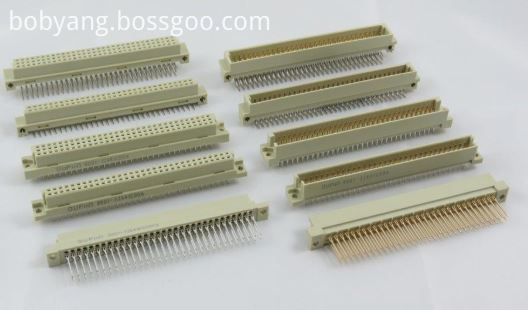
Half C, R, B & Q Type DIN41612 Connectors
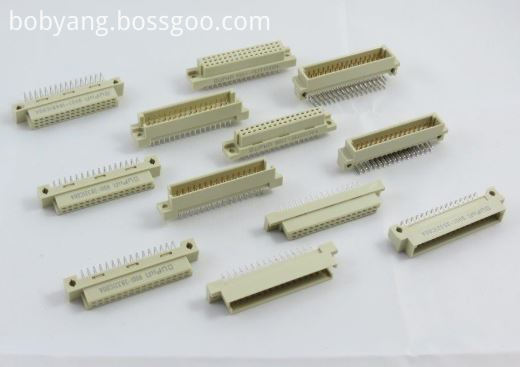
1/3 C,R, B & Q Type DIN41612 Connectors
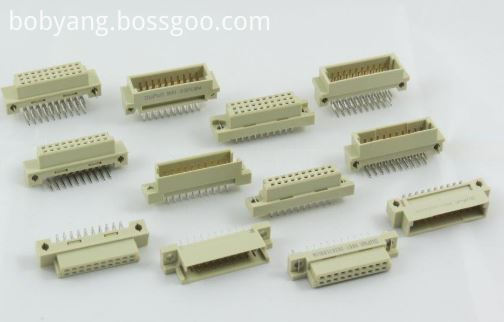
H, F, H+F & M type DIN41612 Connectors
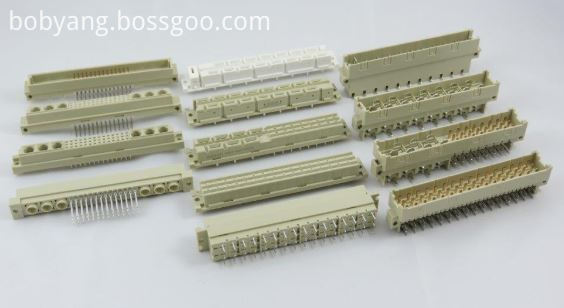
IDC Type DIN41612 Connectors
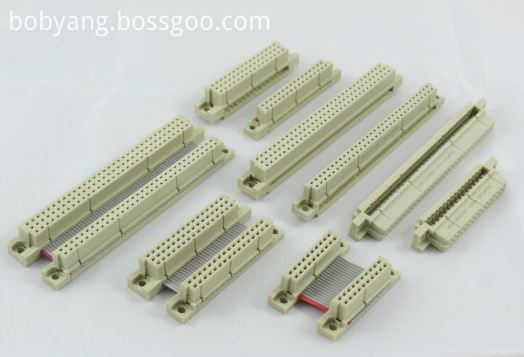
Female Cable Connector
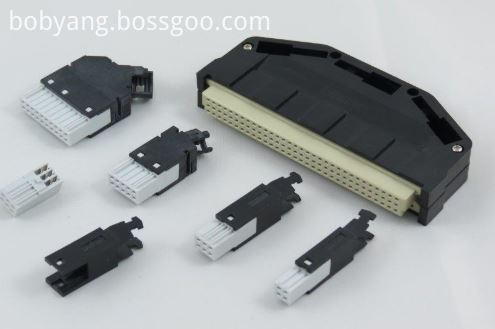
High Pin Count DIN41612 Connectors
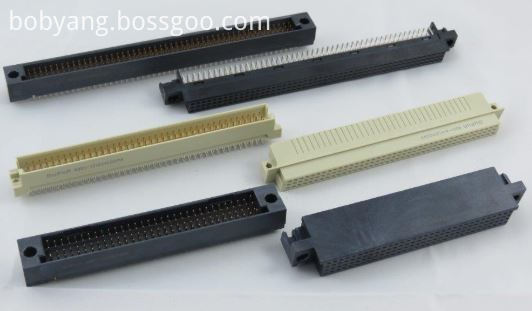
Shroud DIN41612 Connectors
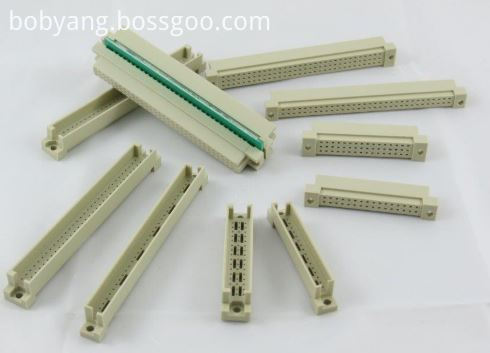
Features and Benefits of Din41612 Connector:
• Indirect mating (male/female)
• Automated production processes
• Continuous quality assurance
• 3-160 contacts
• Complete interconnection system
• Numerous interface connectors
• A wide variety of hoods
• Many termination technologies provide for the lowest installed cost
• Contacts selectively gold-plated
• Tinned terminations for increased solderability
Uses
The primary use of DIN 41612 connectors are PCB Connectors and motherboards, the main acceptance would be their board to board reliable connections.
Applications of Din41612 Connector:
Applications
• Data centers
• Storage
• Servers
• Base stations
• Telecommunications equipment
• Backplane and motherboard assemblies
• Switching systems
• Modular rack systems
• Power automation
• Distributed control systems in
industrial control
• Programmable logic controllers (PLC)
• Robotics
• Test and lab equipment
• Energy distribution
• Monitoring equipment
This is not a definitive list of applications for this product. It represents some of the more common uses.
Din41612 Connector,Din 41612,Eurocard Connector Din41612,Male Din41612 Connector
ShenZhen Antenk Electronics Co,Ltd , https://www.pcbsocket.com